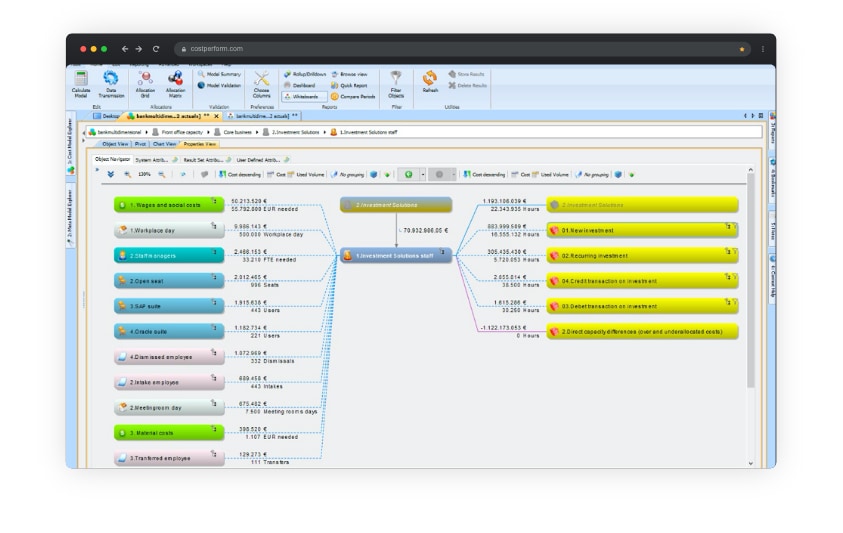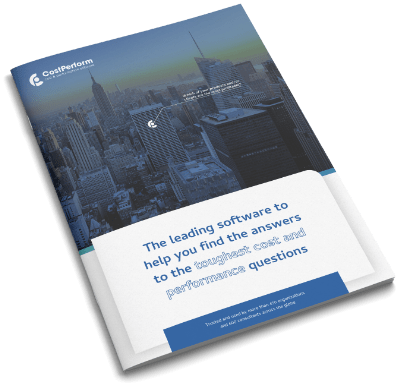CostPerform’s costing methods
Including four predefined tools for cost allocation
When building a cost model, you need the right costing method to allocate costs. Our cost management software lets you choose from four predefined costing methods. On the other hand: you don’t have to choose, because CostPerforms offers the flexibility to use every costing method and all costing methods interchangeably.
What are costing methods?
The chosen costing method in any company or organization determines the level of detail of its cost price. More complex costing methods often lead to a larger data demand in comparison to when using a simple costing method. Depending on your company or organization, your need for detail in your costing model, and the availability of data, you can choose what costing method suits you best.
Four predefined costing methods
What’s unique about CostPerform, is that it’s designed and built to serve any costing method, giving you numerous possibilities to calculate cost prices as accurately as possible. As said before, this doesn’t mean you have to build you own methods from the ground up. Our cost management software comes with predefined costing methods that are commonly used in sectors such as government, finance, healthcare, manufacturing, logistics and telecom.

CostPerform is designed and built to serve any costing method, giving you numerous options to calculate cost prices as accurately as possible
Costing methods: from direct costing to Time-driven ABC
These are the four predefined costing methods coming as standard with CostPerform. Which method you choose depends on the business you’re in, the product or service you’re selling and how in-depth you want to make the cost structure of your company or organization. You don’t necessarily have to choose, because you can use the different costing methods in a cost model interchangeably.
Direct costing
Direct costing is a quick and easy costing method aimed at cost calculation for making decisions on production and sales planning. With direct costing, the price of a product or service can be calculated by assigning only direct costs, but all other costs have to be directly abstracted from the overall results and divided over all products on the basis of one general distribution key.
Activity-based costing (ABC)
This costing method can be used if the costs of a department are a given. Activity-based costing lets you assign the cost of each business activity to all products and/or services, based on an assessment of the relative division of time or volumes. In general, ABC assigns indirect costs more accurately in comparison to direct costing, giving you better insights into the true costs of a product or service.
Rate-based ABC
When choosing this costing method, your cost model has to be set up based on volumes and time standards, because the (budgeted) volumes are the foundation for the calculation of the number of times an activity will have to be executed. By using Rate-based ABC to match the costs of a department or type of employee with the available capacity, it’s possible to determine a per-hour rate. Thanks to RBABC your cost model will provide clear cost insights and new insights into productivity by introducing standards to the organization.
Check the maturity of your current cost modeling endeavors with the Cost Model Maturity scan.
Time-driven ABC
As the name suggests, this is an extension of the activity-based costing method. TDABC uses time equations for the calculation of the time required to execute an entire process, instead of one standard time per activity. In this method, an activity can have multiple cost drivers, reducing the number of activities that have to be defined as a small number of core activities. The source data for these variables can be obtained directly from source systems which store transaction data. TDABC enables the possibility to vary in time per transaction by differing in variations within a transaction, without new activities having to be defined. In your cost model, it also provides data on single transactions, clients and distribution channels, which was difficult to realize in the past. Last but not least: this method is really helpful in multi-dimensional costing.
The conclusion on costing methods
Determining costs and having cost insights is essential for every company and organization. That’s why no cost model can ‘live’ without a costing method, and that’s why CostPerform’s cost management software is designed and built to serve any costing method, giving you numerous possibilities to calculate cost prices as accurately as possible. And to make life even easier, our cost management software comes with four predefined costing methods. This means that when you have CostPerform, you have all the necessary tools at your disposal to effectively manage costs and improve your company’s performance.
